The Global PDRN Skincare Market is projected to grow from USD 321.2 million in 2025 to USD 811.4 million by 2035, at a CAGR of 9.7%.
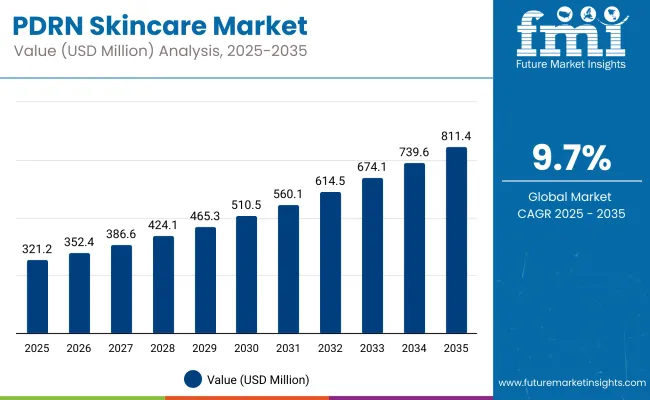
Global PDRN Skincare Market Key Takeaways
| Metric | Value |
|---|---|
| Market Estimated Value in (2025E) | USD 321.2 million |
| Market Forecast Value in (2035F) | USD 811.4 million |
| Forecast CAGR (2025 to 2035) | 9.7% |
Injectables will dominate with a 38.1% market share, while anti-aging and wrinkle reduction will lead the skin concern segment with a 30.7% share in 2025. The Global PDRN Skincare Market is expected to record a valuation of USD 321.2 million in 2025 and USD 811.4 million in 2035, with an increase of USD 490.2 million, which equals a growth of 2.53X over the decade. The overall expansion represents a CAGR of 9.7% and a transformation of the market from a niche clinic-based solution to a global cosmeceutical category.
During the first five-year period from 2025 to 2030, the market increases from USD 321.2 million to USD 510.5 million, adding USD 189.3 million, which accounts for 38.6% of the total decade growth. This phase records steady adoption in aesthetic dermatology, post-laser repair, and premium skin clinics, driven by the need for regenerative precision care. Injectables dominate this period as they cater to over 38% of aesthetic applications requiring immediate cellular regeneration and dermal stimulation.
The second half from 2030 to 2035 contributes USD 300.9 million, equal to 61.4% of total growth, as the market jumps from USD 510.5 million to USD 811.4 million. This acceleration is powered by widespread deployment of cosmeceutical serums, ampoules, and post-procedure masks across both retail and e-commerce platforms. Plant-ferment and recombinant DNA-based PDRN formats begin capturing market share alongside salmon-derived leaders. Online DTC platforms, pharmacies, and aesthetic clinics drive revenue scale, while multi-step skincare routines, subscription-based product models, and dermaceutical brand launches increase the reach of PDRN-infused products.
From 2020 to 2024, the Global PDRN Skincare Market grew from a niche injectable category to a highly specialized regenerative solution in premium dermatology clinics. During this period, the competitive landscape was dominated by clinical equipment and injectables, controlling nearly 70% of revenue, with leaders such as PharmaResearchand, Mastelli S.r.l. focusing on injectable precision care for scar healing and post-laser rejuvenation.
Competitive differentiation relied on source origin (salmon DNA), formulation bioavailability, and speed of recovery enhancement, while topical products were primarily limited to post-procedure adjuncts. Demand for PDRN skincare products will expand to USD 321.2 million in 2025, and the revenue mix will shift as serums, creams, and masks grow to over 60% share. Traditional injectable leaders face rising competition from cosmetic skincare brands offering plant-based or recombinant alternatives, cloud-based DTC commerce, and subscription skincare.
Major players are pivoting toward hybrid clinical-retail models, integrating aesthetic-grade actives with consumer accessibility. Emerging entrants specializing in multi-step routines, ingredient transparency, and regulatory-grade innovation are gaining share. The competitive advantage is moving away from injectable formulation alone to brand ecosystem strength, online influence, and cosmeceutical positioning.
The growth of the Global PDRN Skincare Market is driven by increased adoption of regenerative cosmetic actives, especially Polydeoxyribonucleotide (PDRN), known for its ability to stimulate tissue repair, enhance collagen synthesis, and accelerate post-procedure skin recovery. Injectables such as mesotherapy and skinboosters are gaining popularity in aesthetic clinics for immediate rejuvenation, while serums, creams, and sheet masks infused with PDRN are expanding access via direct-to-consumer (DTC) and e-commerce channels.
Consumer interest in anti-aging, scar reduction, and post-laser recovery is fueling demand for both in-clinic and at-home solutions. The clinical success of salmon-derived PDRN continues to dominate the ingredient landscape, but synthetic and vegan alternatives are emerging to meet ethical, halal, and vegan certification requirements. Innovation in formulation technology, including microencapsulation, liposomal delivery, and multi-layered skin absorption systems, is expanding PDRN’s use in sensitive-skin applications, while digital-first beauty brands are accelerating awareness through social commerce and influencer-led marketing.
The market is segmented by product type, skin concern, PDRN source type, distribution channel, and region. Product types include injectables, serums, creams, masks, lotions, eye treatments, and post-procedure gels, representing both clinical and consumer-facing formats. Skin concerns covered are anti-aging, skin repair, pigmentation, hydration, scar reduction, sensitivity, and firming, reflecting key cosmetic use cases.
Source types include salmon-derived, trout-based, synthetic, and vegan PDRN, meeting diverse regulatory and ethical preferences. Distribution spans e-commerce marketplaces, DTC websites, pharmacies, beauty stores, clinics, and professional distributors, highlighting omni-channel reach. Regionally, the market covers North America, Europe, Asia-Pacific, Middle East, and Africa, with top growth expected in the USA, China, India, Japan, and Germany.
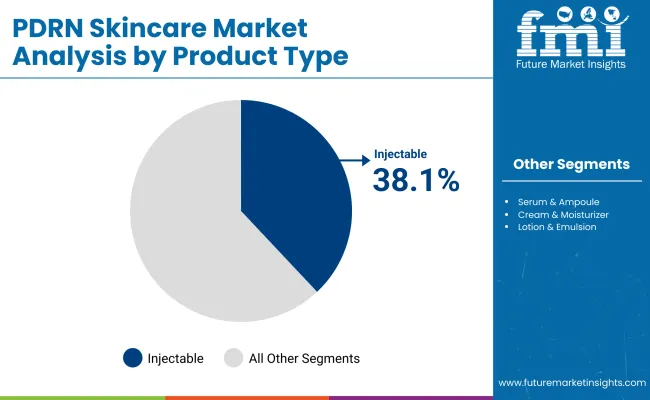
| Product Type Segment | Market Value Share, 2025 |
|---|---|
| Injectables | 38.1% |
| Others | 61.9% |
The injectables segment is projected to contribute 38.1% of the Global PDRN Skincare Market revenue in 2025, maintaining its lead as the dominant product type category. This is driven by ongoing demand for in-clinic skin rejuvenation treatments offering targeted delivery, high efficacy, and fast recovery outcomes. Aesthetic professionals continue to prioritize injectable formats for their ability to stimulate collagen, reduce wrinkles, and enhance skin texture.
The segment’s growth is also supported by expanding dermatology and aesthetic clinic networks, especially across Asia-Pacific, the Middle East, and North America. As topical PDRN products gain visibility in retail and DTC spaces, injectables are expected to retain their clinical edge due to regulated administration and premium outcomes. The injectables segment is expected to remain the cornerstone of professional-grade PDRN skincare treatments.
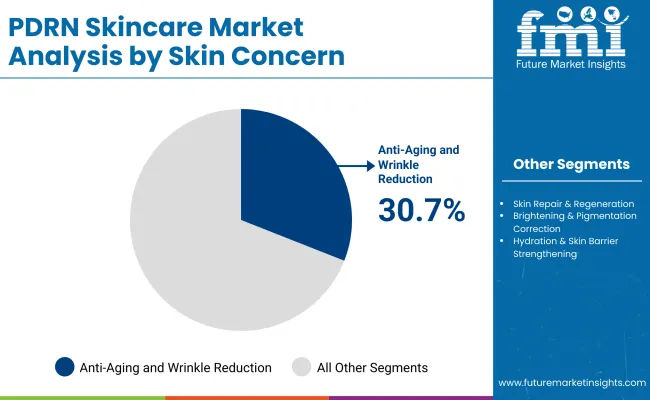
| Product Type Segment | Market Value Share, 2025 |
|---|---|
| Anti-aging and wrinkle reduction | 30.7% |
| Others | 69.3% |
The anti-aging and wrinkle reduction segment is projected to contribute 30.7% of the Global PDRN Skincare Market revenue in 2025, securing its position as the leading application segment. Demand is fueled by growing consumer awareness around regenerative skincare, preventive aging strategies, and evidence-backed solutions for fine lines and sagging.
This segment benefits from rising consumer investment in cosmeceuticals and aesthetic procedures focused on skin longevity. PDRN’s efficacy in stimulating fibroblast activity and dermal repair makes it a preferred active in both clinical and consumer product lines targeting signs of aging. Anti-aging is expected to continue leading demand across all geographic and demographic segments.
| Product Type Segment | Market Value Share, 2025 |
|---|---|
| Salmon-Derived PDRN | 72.3% |
| Others | 27.7% |
The salmon-derived PDRN segment is projected to contribute 72.3% of the Global PDRN Skincare Market revenue in 2025, holding its lead as the dominant source type. This dominance is attributed to salmon DNA’s proven biocompatibility, high safety profile, and strong clinical results in skin regeneration, wound healing, and post-laser recovery.
The segment’s strength is further supported by widespread regulatory approval and established sourcing channels across Korea, Japan, and Europe. While synthetic and vegan alternatives are gaining interest, salmon-derived PDRN remains the preferred base for premium injectable and topical formulations. The segment is expected to remain the gold standard in PDRN sourcing throughout the forecast period.
Drivers
Clinical Spillover into Consumer Channels
The expansion of PDRN from in-clinic injectables into consumer-grade formulations like serums, masks, and creams is driving retail penetration. Brands are leveraging clinical efficacy data to develop cosmeceutical lines that promise medical-grade outcomes without proceduresbridging the gap between dermatology and daily skincare. This dual-channel positioning (clinic + retail) significantly boosts global market reach.
Regulatory Comfort with Marine-Derived DNA Countries like South Korea, Japan, and select EU nations have established precedents for approving salmon-derived PDRN in both aesthetic and OTC products. This regulatory clarity is lowering entry barriers for product expansion in high-income markets, enabling multi-format launches (injectables + topicals) under a unified compliance frameworkunlike other emerging actives still undergoing classification.
Restraints
Cold Chain Dependency for PDRN Stability
PDRN’s molecular integrity is highly sensitive to temperature and light exposure, especially in aqueous serum and gel formulations. Without stable encapsulation technologies, brands face cold chain logistics challengesraising storage, shipping, and retail handling costs, particularly in Southeast Asia, LATAM, and Africa.
Ethical and Religious Certification Challenges
Despite rising global interest, salmon-derived DNA faces pushback in halal, vegan, and plant-based clean beauty markets. This limits adoption in Muslim-majority countries (Indonesia, UAE, Malaysia) and among ethically-conscious Western consumers unless clear certification or alternative sourcing is adoptedrestricting addressable market share.
Key Trends
Rise of Plant-Ferment and Recombinant PDRN Alternatives
Several K-beauty and biotech labs are investing in plant-ferment derived nucleotides and synthetic recombinant PDRN as cruelty-free, halal-compliant, and thermally stable alternatives to marine DNA. These formats are expected to capture early attention from vegan skincare brands and cosmetic lines entering the GCC and ASEAN halal markets.
PDRN-as-a-Service via Clinical Franchise Models
Brands like Rejuran are rolling out standardized PDRN-based facial treatments through certified clinics globallyespecially in China, UAE, and Thailand. This “treatment-as-a-product” model is setting a trend where the product is not just sold but delivered as a service, increasing patient loyalty and allowing clinic chains to monetize patented protocols and branding under a recurring model.
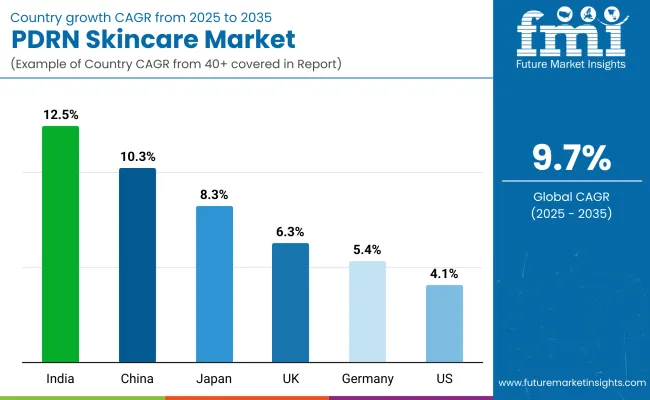
| Countries | CAGR (2025 to 2035) |
|---|---|
| China | 10.3% |
| India | 12.5% |
| Germany | 5.4% |
| USA | 4.1% |
| UK | 6.3% |
| Japan | 8.3% |
The global PDRN Skincare Market shows a pronounced regional disparity in adoption speed, shaped by cosmetic clinical infrastructure, consumer sensitivity to regenerative actives, and regulatory acceptance of DNA-based ingredients. Asia-Pacific emerges as the fastest-growing region, anchored by China at 10.3% CAGR and India at 12.5%. This acceleration is driven by widespread popularity of injectable skin boosters, K-beauty-inspired PDRN topicals, and strong consumer trust in post-laser regenerative skincare.
China’s market benefits from widespread aesthetic clinic chains, social media marketing of anti-aging actives, and early mainstreaming of salmon-derived DNA actives, pushing demand across both retail and in-clinic channels. India’s growth trajectory reflects expanding dermatology access, the rise of cosmeceutical DTC brands, and early adoption of PDRN-infused hydration and repair solutions for sensitive skin and pigmentation.
Europe maintains a moderate growth profile, led by Germany at 5.4% CAGR and the UK at 6.3%, supported by cosmetic-grade PDRN approvals, clinical spa offerings, and dermatology-led brand expansions. European consumers show high interest in scar repair and skin firming products, especially among aging populations and post-procedure users. EU safety regulations and pharmaceutical-grade quality expectations restrict lower-tier players, favoring clinically validated brands. North America shows steady expansion, with the USA growing at 4.1% CAGR, despite already holding one of the largest global market shares in 2025.
The region reflects clinical maturity and a high base of aesthetic procedures such as microneedling and mesotherapy. Growth is more service-driven, with demand concentrated in professional-grade injectables, recovery gels, and hybrid skincare-clinical retail lines. Increasing availability of PDRN-backed clinical studies, alongside FDA-compliant cosmeceutical launches, supports long-term market formalization.
| Year | USA PDRN Skincare Market (USD Miilion) |
|---|---|
| 2025 | 74.52 |
| 2026 | 81.50 |
| 2027 | 89.14 |
| 2028 | 97.50 |
| 2029 | 106.64 |
| 2030 | 116.64 |
| 2031 | 127.57 |
| 2032 | 139.53 |
| 2033 | 152.61 |
| 2034 | 166.92 |
| 2035 | 182.57 |
Growth and Expansion Outlook for PDRN Skincare Market in the United States The PDRN Skincare Market in the United States is projected to grow at a CAGR of 4.1%, holding a 23.2% global market share in 2025, which is expected to slightly decline to 22.5% by 2035. Growth is driven by increasing adoption across aesthetic dermatology clinics, post-procedure skincare regimens, and cosmeceutical brands expanding into regenerative actives.
Injectables remain the top-performing product type, with growing usage in mesotherapy and microneedling support. Recovery gels and targeted ampoules are gaining traction within dermatology chains and med-spas. The USA consumer base exhibits high preference for clinically backed actives, encouraging partnerships between biotech firms and skincare brands.
The PDRN Skincare Market in the United Kingdom is expected to grow at a CAGR of 6.3%, with its global market share rising from 8.2% in 2025 to 9.1% in 2035. Demand is supported by post-procedure skin repair, advanced anti-aging solutions, and expansion of cosmetic dermatology clinics and pharmaceutical beauty lines. Clinics are also introducing PDRN-based regimens for skin sensitivity and rosacea. Public health awareness and aging population trends continue to drive interest in DNA-based skin regeneration products.
India is witnessing rapid growth in the PDRN Skincare Market, with a forecast CAGR of 12.5% through 2035. The country’s global market share is projected to grow from 5.1% in 2025 to 5.6% in 2035. Tier-2 and Tier-3 cities are seeing increased awareness of DNA-based skincare via dermatology chains and influencer-led product launches. Hydration, pigmentation correction, and post-acne scar repair are key use cases. Brands are offering affordable ampoule kits and peptide-infused moisturizers tailored to the Indian skin profile. Clinical dermatology, e-commerce platforms, and cosmeceutical startups are collectively boosting demand.
| Countries | 2025 |
|---|---|
| China | 13.2% |
| India | 5.1% |
| Germany | 12.3% |
| USA | 23.2% |
| UK | 8.2% |
| Japan | 7.1% |
| Countries | 2035 |
|---|---|
| China | 12.4% |
| India | 5.6% |
| Germany | 14.9% |
| USA | 22.5% |
| UK | 9.1% |
| Japan | 8.1% |
The PDRN Skincare Market in China is expected to grow at a CAGR of 10.3%, with its global market share slightly declining from 13.2% in 2025 to 12.4% in 2035. This growth is driven by K-beauty influence, dominance of injectable boosters, and extensive clinical adoption in aesthetic hospitals. Brands offering salmon-derived PDRN products have seen strong traction in the anti-aging and post-laser recovery categories. The market is rapidly maturing, with widespread adoption of ampoules, sheet masks, and topical skin boosters across both premium clinics and mid-tier skincare retailers.
| Product Segment | Market Value Share, 2025 |
|---|---|
| Injectables | 32.1% |
| Others | 67.9% |
The PDRN Skincare Market in the USA is valued at USD 74.52 million in 2025, with injectables leading at 32.1% (USD 23.92 million), followed by other product formats at 67.9% (USD 50.60 million). The dominance of injectables is supported by the country’s advanced clinical infrastructure, high demand for minimally invasive aesthetic procedures, and strong dermatologist-driven product adoption. USA consumers show a marked preference for in-clinic treatments offering rapid results, with PDRN injectables positioned as premium solutions for skin repair, anti-aging, and post-procedure recovery.
Ongoing FDA clearances, medical-grade formulation innovations, and the integration of PDRN injectables into combination therapies are expected to sustain growth. The “Others” category, comprising PDRN creams, serums, and masks, benefits from the retail and e-commerce skincare boom, especially within physician-dispensed and medspa channels.
| Skin Concern Segment | Market Value Share, 2025 |
|---|---|
| Anti ‑ Aging & Wrinkle Reduction | 36.7% |
| Others | 67.9% |
The PDRN Skincare Market in China is valued at USD 42.40 million in 2025, with the anti-aging & wrinkle reduction segment leading at 36.7% (USD 15.56 million), followed by other concerns such as skin brightening, hydration, and barrier repair at 63.3% (USD 26.84 million). The strong anti-aging demand is driven by China’s rapidly aging urban population, high disposable income in Tier 1 cities, and the influence of K-beauty-inspired dermal treatments.
Consumers increasingly associate PDRN-based products with professional-grade rejuvenation, fueling adoption both in dermatology clinics and luxury skincare retail. The “Others” segment benefits from the multi-functional skincare trend, where PDRN is incorporated into serums and masks targeting hydration and post-treatment recovery. Local manufacturing capabilities and cross-border e-commerce from Korea further boost accessibility and brand diversification.
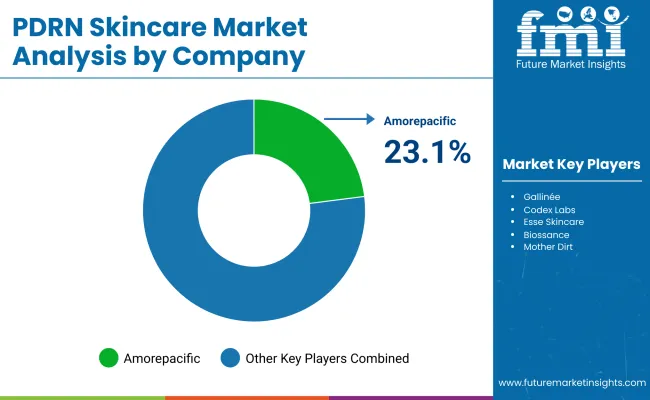
The PDRN Skincare Market is moderately fragmented, with leading biotechnology firms, mid-sized cosmeceutical innovators, and clinical skincare specialists competing across topical and injectable segments. Global biotechnology companies such as PharmaResearch Products Co., Ltd hold a significant market share, driven by patented salmon-derived PDRN formulations, strong medical aesthetics presence, and regulatory-backed credibility.
Their strategies increasingly emphasize clinical trial validation, aesthetic clinic partnerships, and hybrid offerings that span injectables and topical recovery lines. Established mid-sized players, including Dongkook Pharmaceutical, BR PHARM Inc., and HTL Biotechnology, are expanding access through dermocosmetic formats like serums, masks, and post-procedure creams. These companies are accelerating distribution in both clinical and retail settings, with product lines targeted at wrinkle repair, skin regeneration, and post-acne recovery.
Their strength lies in scientific branding, DTC expansion, and K-beauty ecosystem integration. Specialized providers such as BNF Solution, BMI Korea, and CNP Laboratory (LG H&H subsidiary) focus on market-specific niches like vegan PDRN alternatives, plant-ferment topicals, and low-irritation formulas for sensitive skin. These brands leverage customization, product licensing, and regional clinical networks to differentiate their offerings.
Competitive differentiation is shifting away from just ingredient purity toward integrated skincare experiences that combine in-clinic injectables with at-home PDRN maintenance. Strategic focus now includes dermatologist-backed endorsement, multi-channel retail presence, and recurring revenue through DTC kits and subscription skincare models.
Key Developments in Global PDRN Skincare Market
| Item | Value |
|---|---|
| Quantitative Units | USD 321.2 million |
| Product Type | Injectables, Serums & Ampoules, Creams & Moisturizers, Sheet Masks & Hydrogel Masks, Lotions & Emulsions, Eye Creams & Targeted Spot Treatments, Post-Procedure Recovery Gels |
| Skin Concern | Anti-Aging & Wrinkle Reduction, Skin Repair & Regeneration, Brightening & Pigmentation Correction, Hydration & Skin Barrier Strengthening, Scar & Acne Mark Reduction, Sensitive Skin & Redness Relief, Skin Firming & Elasticity Boosting |
| PDRN Source Type | Salmon-Derived PDRN, Trout-Derived or Fish-Agnostic Marine PDRN, Synthetic / Recombinant DNA, Vegan or Plant-Ferment Based Alternatives |
| Distribution Channel | Online Retail (E-commerce Marketplaces, Brand-Owned DTC Websites), Offline Retail (Beauty Specialty Stores, Pharmacies / Drugstores, Department Stores), Aesthetic Clinics & Dermatology Centers, Professional Distribution / Med-Spas, B2B Aesthetic Product Distributors |
| End-use Industry | Automotive, Aerospace & defense, Consumer electronics, Healthcare, Oil & gas, Energy and power, and Others |
| Regions Covered | North America, Europe, Asia-Pacific, Latin America, Middle East & Africa |
| Country Covered | United States, Canada, Germany, France, United Kingdom, China, Japan, India, Brazil, South Africa |
| Key Companies Profiled | FARO Technologies, Inc., 3D Digital Corporation, 3D Systems, Inc., Autodesk, Inc., Artec 3D, Automated Precision, Inc. (API), Carl Zeiss Optotechnik GmbH, Creaform Inc., Direct Dimensions Inc., GOM GmbH, Hexagon AB, Konica Minolta, Inc., NextEngine Inc., Nikon Corporation, OGI Systems Ltd, and ShapeGrabber |
| Additional Attributes | Dollar sales by product type and skin concern, adoption trends in clinical dermatology and post-procedure aesthetics, rising demand for injectables and topical PDRN formulations, sector-specific growth in professional dermatology centers, med-spas, and luxury skincare retail, channel-wise revenue segmentation across B2B distributors, clinics, and direct-to-consumer e-commerce, integration with regenerative skincare regimens and anti-aging protocols, regional trends influenced by consumer education and K-beauty/C-beauty routines, and innovations in marine-derived PDRN sourcing, microneedle delivery systems, and hydrogel-based carriers. |
The global PDRN Skincare Market is estimated to be valued at USD 321.2 million in 2025.
The market size for the PDRN Skincare Market is projected to reach USD 811.4 million by 2035.
The PDRN Skincare Market is expected to grow at a CAGR of 9.7% between 2025 and 2035.
The key product types in the PDRN Skincare Market are Injectables, Serums & Ampoules, Creams & Moisturizers, Sheet Masks & Hydrogel Masks, Lotions & Emulsions, Eye Creams & Targeted Spot Treatments, and Post-Procedure Recovery Gels.
In terms of product type, Injectables segment is projected to command a 38.1% share in the PDRN Skincare Market in 2025.






Full Research Suite comprises of:
Market outlook & trends analysis
Interviews & case studies
Strategic recommendations
Vendor profiles & capabilities analysis
5-year forecasts
8 regions and 60+ country-level data splits
Market segment data splits
12 months of continuous data updates
DELIVERED AS:
PDF EXCEL ONLINE
PDRN Supplements Market Size and Share Forecast Outlook 2025 to 2035
Skincare Supplement Market Size and Share Forecast Outlook 2025 to 2035
Skincare Oil Market Size and Share Forecast Outlook 2025 to 2035
Skincare Nutritional Serum Market Size and Share Forecast Outlook 2025 to 2035
Skincare Products Market Size and Share Forecast Outlook 2025 to 2035
Skincare Market Analysis - Size, Share, and Forecast Outlook 2025 to 2035
Skincare Packaging Market Size, Share & Forecast 2025 to 2035
Skincare Industry in India – Trends & Growth Forecast 2024-2034
Global Skincare Treatment Market Analysis – Size, Share & Forecast 2024-2034
Men’s Skincare Products Market Size, Growth, and Forecast for 2025 to 2035
Global Smart Skincare Market Size and Share Forecast Outlook 2025 to 2035
Cooling Skincare Gels Market Size and Share Forecast Outlook 2025 to 2035
Natural Skincare Preservatives Market Analysis - Size and Share Forecast Outlook 2025 to 2035
Ormedic Skincare Market Demand & Insights 2024-2034
Ceramide Skincare Market Size and Share Forecast Outlook 2025 to 2035
BPA-Free Skincare Market Trends – Demand & Forecast 2024-2034
Camellia Skincare & Cosmetics Market
Buffering Skincare Products Market Analysis - Size and Share Forecast Outlook 2025 to 2035
Menopause Skincare Solutions Market Size and Share Forecast Outlook 2025 to 2035
Probiotic Skincare Ingredients Market Size and Share Forecast Outlook 2025 to 2035

Thank you!
You will receive an email from our Business Development Manager. Please be sure to check your SPAM/JUNK folder too.
Chat With
MaRIA